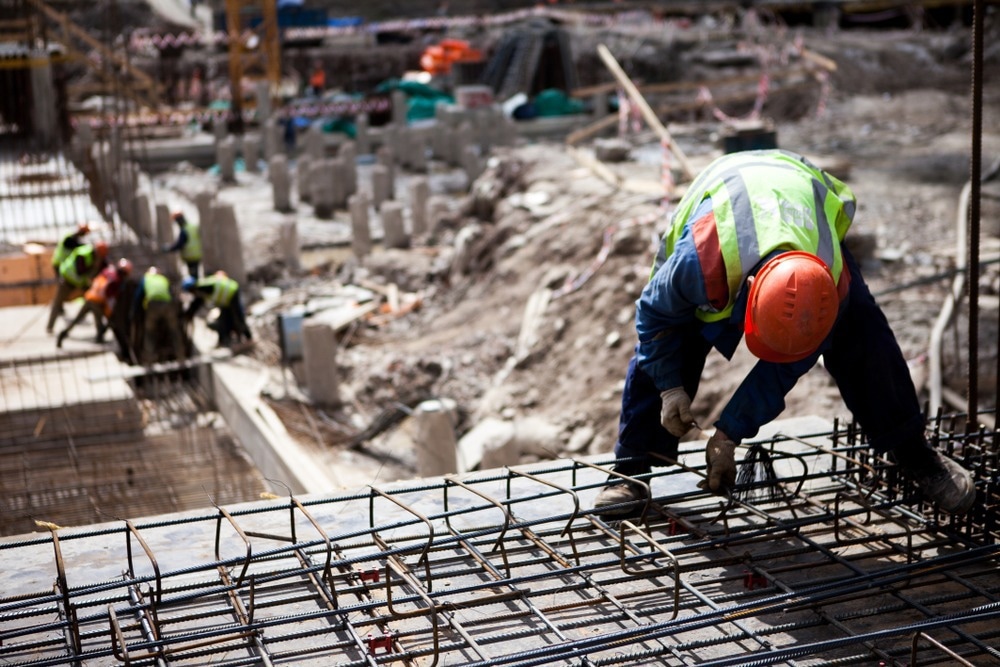Concrete is the most commonly used construction material for key infrastructure and buildings, but pure concrete cannot meet the stringent demands of the construction industry. To improve its strength and durability, concrete is commonly reinforced with various materials.

Image Credit: Htneim/Shutterstock.com
How Reinforced Concrete Works
Concrete has a long history of use stretching back to ancient times, with precursor materials emerging in the Middle East around 1300 BC. The Romans made widespread use of concrete in structures such as The Pantheon and critical infrastructure such as bridges.
Today, concrete is used to construct everything from relatively small buildings to grand projects such as dams, bridges, tunnels, and airports. In order to ensure the safety of individuals, construction materials such as concrete must be extremely durable and able to withstand environmental stresses.
Reinforced concrete has almost double the strength of plain concrete. Not all concrete requires reinforcement, but to avoid structural failure, reinforced concrete is used in foundations, footings, slabs, and columns.
Reinforced concrete improves the durability and lifespan of structures due to concrete’s compressive strength and the tensile strength of the reinforcing element. Additionally, the thermal characteristics of concrete and steel, the most commonly used reinforcement material, are similar.
This similarity in thermal characteristics allows the concrete and reinforcing material (steel) to expand and contract at similar rates. Therefore, both materials function as a single unit, allowing reinforced concrete to withstand far higher environmental stresses, vibrations, and seismic events than plain concrete.
Common Reinforcement Techniques
Since its invention in the late 19th century, reinforced concrete has revolutionized the construction industry. It can be said that reinforced concrete has built the modern world, as critical modern infrastructure projects would not be possible without it.
As previously mentioned, steel is the most commonly used reinforcing material. Two methods are used: steel rebar and mesh panels. These two techniques require different preparation methods.
Steel rebar is positioned at regular intervals across the concrete slab, both length- and widthways. Appropriate positioning tools and reinforcement ties ensure that the rebar grid is correctly positioned and will not move during the concrete pour.
Steel mesh is more appropriate for larger construction projects as it is more cost-effective and easier to install in large slabs. Mesh is placed across the slab with appropriate overlaps, ensuring equal reinforcement across all areas.
New Reinforcement Materials
Whilst steel is the preferred material in reinforced concrete and ensures the safety and durability of concrete structures, there are some issues with its widespread manufacture and use. Steel is expensive, prone to rust, and its manufacture is a key contributor, along with concrete, to climate change in the construction industry.
To address the historical issues with the construction industry and help the sector achieve its net zero goals without compromising on the quality and durability of reinforced concrete structures, a number of alternative reinforcement materials have been developed in recent years.
Stainless steel reinforcement bars are low-carbon content materials with high corrosion resistance due to their chromium content. Chromium forms a layer on the surface of the stainless steel, which is responsible for the material’s superior corrosion resistance compared to conventional steel bars.
Stainless steel is considerably more expensive than standard steel bars, however. Their use must be considered carefully in construction projects to optimize the trade-off between performance and cost. Stainless steel bars are recommended for use in parking garages, jetties, moorings, retaining walls, piers, retaining walls, and columns.
Epoxy-coated rebars (also known as green bars) improve corrosion resistance and enhance the strength of reinforced concrete. More cost-effective than stainless steel (up to eight times cheaper), the quality of the coating is essential to ensure optimum corrosion resistance.
Fiber reinforcement polymers (FRPs) have emerged as viable alternatives to conventional steel rebars in recent years, moving increasingly from the lab to commercial applications. Fiber reinforcements improve the tensile strength and stiffness of concrete structures.
These green, low-carbon alternatives to steel incorporate fiber reinforcements, fillers, resins, and additives. A key benefit is their superior corrosion resistance compared to steel reinforcement. Furthermore, resins used in FRPs possess high compressive strength and bind the entire concrete mix, producing an extremely firm mass.
Several fibers have been investigated in studies for their use in FRPS, including fiberglass, carbon fiber, and aramid. Carbon fiber is, however, expensive, which limits its use in large-scale construction projects.
Another option that has been explored extensively in recent years is the use of recycled waste materials in FRPs. This satisfies the aims of the circular economy and helps to reduce the carbon footprint of new structures. Both natural and synthetic recycled fibers have been studied for their potential as reinforcement materials.
In Summary
Reinforcing concrete is essential to ensure that buildings and infrastructure can satisfy rigorous demands and withstand environmental stresses. Steel is a commonly used material, but in recent years new and innovative materials have started to emerge which overcome historical issues with steel use.
As the world moves toward a low-carbon, circular economic model, the use of fiber-reinforced polymers and recycled materials will likely increase, presenting new opportunities for low-cost green construction and the reduction of greenhouse gas emissions without compromising quality, safety, and durability.
More from AZoBuild: Nanomaterials in Construction: Properties, Performance, and Applications
Further Reading and More Information
Meri, R et al. (2020) Recycled fibers in reinforced concrete: A systematic literature review Journal of Cleaner Production 248, 119207 [online] sciencedirect.com. Available at:
https://www.sciencedirect.com/science/article/abs/pii/S0959652619340776
The Constructor (website) How to Choose the Right Reinforcement Material? [online] theconstructor.org. Available at:
https://theconstructor.org/practical-guide/right-reinforcement-material/47922/
Britannica (website) Reinforced concrete [online] britannica.com. Available at:
https://www.britannica.com/technology/reinforced-concrete
Disclaimer: The views expressed here are those of the author expressed in their private capacity and do not necessarily represent the views of AZoM.com Limited T/A AZoNetwork the owner and operator of this website. This disclaimer forms part of the Terms and conditions of use of this website.